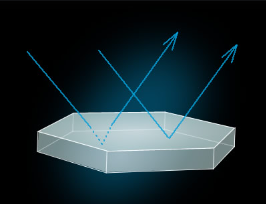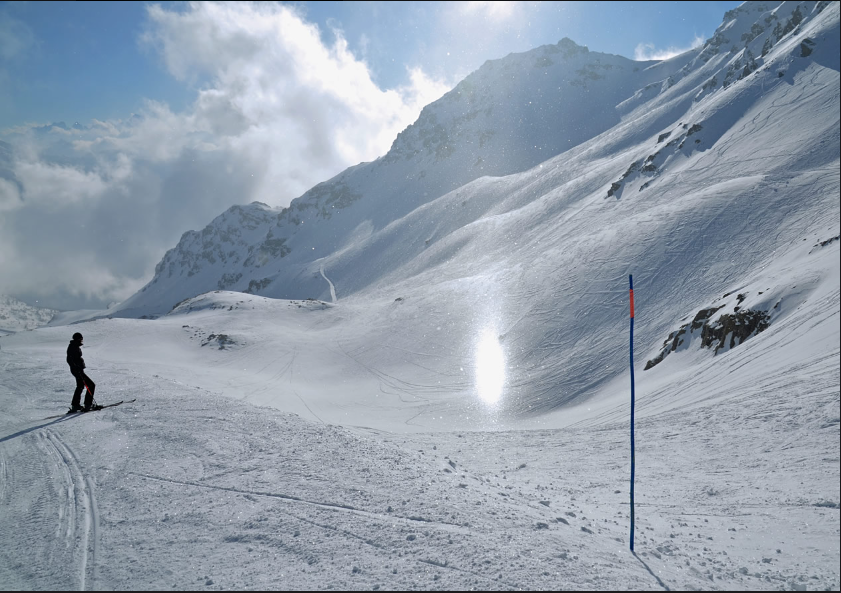OPOD - Diamond Dust Subsun
OPOD - Diamond Dust Subsun: A Captivating Phenomenon Explained
Have you ever witnessed a mesmerizing display of twinkling lights on a snowy ski slope? Wim van Zanten, a lucky observer at Orelle Les Trois Vallées in France, captured a stunning video of what is known as a "twinkling subsun." The scene was truly enchanting, with countless spots of light swirling, dancing, and flashing in the air. While it may seem like these glints are from tumbling and rotating snowflake-like crystals, the reality is quite different. In fact, what we are witnessing is the reflection of sunlight by well-aligned hexagonal plate crystals.
The hexagonal plate crystals responsible for this captivating phenomenon slowly drift downwards amidst the chaotic air currents surrounding them. As these crystals descend, their aerodynamic drag keeps them aligned so that their large hexagonal faces remain horizontal to within a degree or so. It is this alignment that allows the crystals to reflect sunlight externally from their upper faces or internally from their lower faces. Together, these countless crystals act as a giant mirror, forming an intense sun image below the horizon at the same distance as the sun above it.
Wim's subsun, like most, appears vertically elongated due to a slight wobble in the crystals' perfect horizontal alignment. The size of the crystals influences the extent of this wobble, and larger crystals tend to create a sun pillar instead of a subsun. If you closely examine Wim's video, you can even spot a fainter sun pillar accompanying the subsun.
The diamond dust subsun phenomenon is truly a testament to the intricate beauty of nature. However, understanding the science behind it only enhances our appreciation for this breathtaking display. Here are some key points to consider:
-
Temperature: The subsun observed by Wim van Zanten occurred in freezing temperatures of -15 degrees Celsius. Such low temperatures are ideal for the formation and stability of diamond dust, which consists of tiny ice crystals suspended in the air.
-
Twinkling Effect: The intense twinkling effect seen in the subsun is a result of the light being scattered by the countless ice crystals suspended in the air. As sunlight passes through these crystals, it undergoes refraction and reflection, creating a mesmerizing dance of light.
-
Polarizing Ski-Glasses: Wim mentioned that the subsun appeared even more intense when viewed through his polarizing ski-glasses. This could be due to the polarization filter reducing glare and enhancing contrast, making the subsun's shimmering effect more pronounced.
-
Hexagonal Plate Crystals: The diamond dust responsible for creating the subsun consists of hexagonal plate crystals. These crystals align themselves horizontally due to aerodynamic drag as they descend through the air. Their reflective properties allow them to act as mirrors, redirecting sunlight towards the observer.
-
Vertical Elongation: The slight wobble in the alignment of the hexagonal plate crystals causes the subsun to appear vertically elongated. This wobble is more pronounced in larger crystals, which can create a sun pillar instead of a subsun.
-
Fainter Sun Pillar: In Wim's video, there is a fainter sun pillar accompanying the subsun. Sun pillars occur when sunlight reflects off horizontal ice crystals in the atmosphere, creating a vertical column of light extending above or below the sun.
Witnessing a diamond dust subsun is a rare and captivating experience. It serves as a reminder of the intricate beauty that can be found in the natural world. Next time you find yourself surrounded by snowflakes and freezing temperatures, keep an eye out for this enchanting atmospheric optics phenomenon.
Diamond Dust Subsun
Wim van Zanten took this video of a twinkling subsun on a ski slope at Orelle Les Trois Vall�es, France. A wider angle still image is below
"It was a beautiful sight but difficult to capture. Through my polarizing ski-glasses it looked even more intense. The temperature was -15 Celsius. It was an intense twinkling of the ice-crystals 3 feet above the ground visible only between the observer and the sun."

While watching these myriad spots of light swirling, dancing and flashing in the nearby air it is hard not to imagine that the glints are from tumbling and rotating snowflake-like crystals. The opposite is true, facets of well aligned hexagonal plate crystals are reflecting the sun's light towards the eye and camera.
Each plate is drifting slowly downwards relative to its local and rather chaotic air current. Its relative downward motion induces aerodynamic drag that keeps the crystal aligned so that its large hexagonal faces are horizontal to within a degree or so.
Sunlight reflects externally from the exposed upper face or internally from the lower one. Collectively the host of crystals act as a large mirror that forms an intense sun image the same distance below the horizon as the sun above it.
Wim's subsun, like most, is vertically elongated because the crystals have a slight wobble from a perfect horizontal alignment. Large crystals wobble more and make a sun pillar rather than a subsun. There is a fainter sun pillar in Wim's video and the image below.

Note: this article has been automatically converted from the old site and may not appear as intended. You can find the original article here.
Reference Atmospheric Optics
If you use any of the definitions, information, or data presented on Atmospheric Optics, please copy the link or reference below to properly credit us as the reference source. Thank you!
-
<a href="https://atoptics.co.uk/blog/opod-diamond-dust-subsun/">OPOD - Diamond Dust Subsun</a>
-
"OPOD - Diamond Dust Subsun". Atmospheric Optics. Accessed on April 20, 2024. https://atoptics.co.uk/blog/opod-diamond-dust-subsun/.
-
"OPOD - Diamond Dust Subsun". Atmospheric Optics, https://atoptics.co.uk/blog/opod-diamond-dust-subsun/. Accessed 20 April, 2024
-
OPOD - Diamond Dust Subsun. Atmospheric Optics. Retrieved from https://atoptics.co.uk/blog/opod-diamond-dust-subsun/.